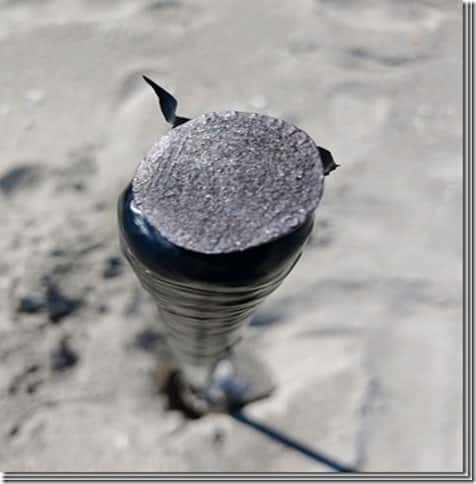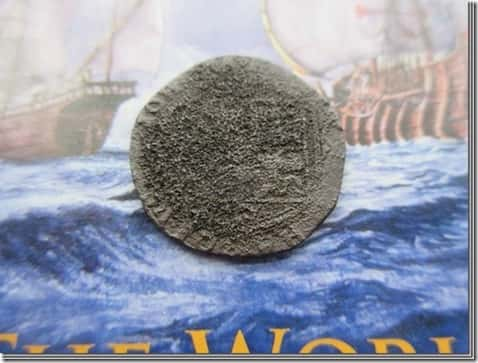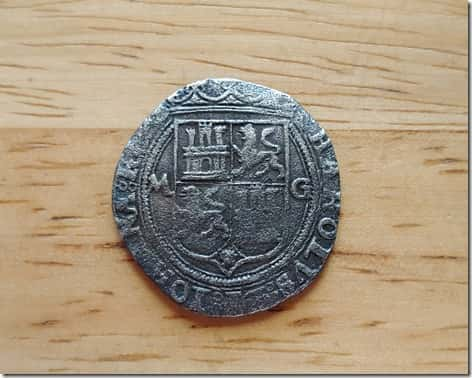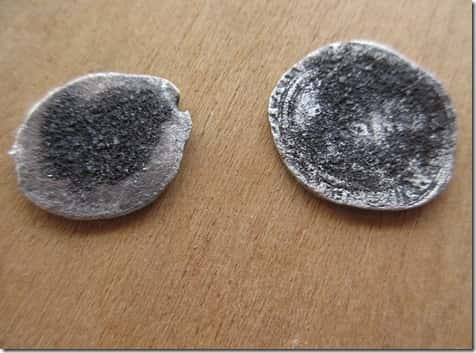A Carlos and Juana Spanish 2 Reale Coin
Published by Terry S. on 01/12/22
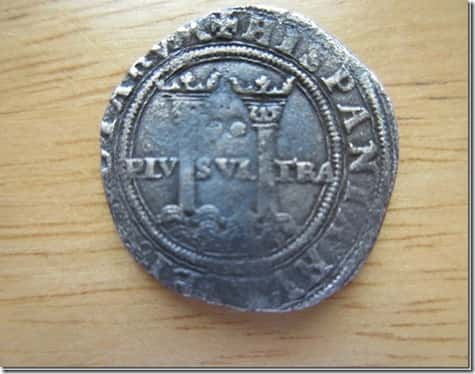 In 2020 I was detecting a remote Treasure Coast beach when I discovered an area mid beach that was just loaded with coins. It was about 4 days after a full moon phase where we had just experienced an extreme plus and minus tide and and being the tide was backing down more each day I had several days before the full moon phase and the tides would reach this area again. On the first day I dug a bunch of coins but I had to quit early because I had a dinner commitment. On day two I returned to the area and one of the coins I recovered was a very different and very encrusted coin. This [second] picture was taken right after the coin was dug, it was a little larger than a quarter and I thought I could see the outline of the shield on one side. I called my friend Jerry Pope and told him that I thought that I had found a Spanish reale. Jerry came over and looked at it and he wasn’t sure what it was either. This [third] picture was taken after I brought the coin home and had partially cleaned it. At this point I was certain the it was an older Spanish reale. I showed it to a well know archaeologist and he told me that it was an old world Spanish Carlos & Juana coin dating back to the 16th century. I took the coin to Steve Hodges of West Bay Trading Company and asked him to clean the coin for me and as you can see he did a great job [shown in first image]. The two round dots between the two pillars indicate that the coin is a two reale. This [fourth picture] is the back of the coin, the M on the left indicates the coin was minted in Mexico. The G on the right side is for the assayer Juan Gutierrez who worked from 1544 and retired in 1548. This positively dates this coin from 1544 to 1548 and I believe it makes it one of the oldest if not the oldest Spanish coin found with a metal detector on the Treasure Coast. Steve made me this certificate of authenticity which certainly adds a a lot if you want to display the coin. Now to complete this story I continued to detect this small area for three days. I dug many more coins including the coin pictured on the left. Because of the unique encrustation I believe it may be a second Carlo & Juana coin. Steve Hodges has the coin and believes that he has a process that will not only clean it but will bring out more detail. I was using a
Minelab equinox 800 and had gridded the area from several angles. I have since purchased a Garrett Sea Hunter, a pulse machine. When you run into an area that is loaded with targets you will naturally detect the area until you believe that you have found all that is there. Wouldn’t it be nice to be able to return one more time with a pulse machine that is capable of reaching more depth and detect this previously target rich area that you cleaned out one more time. If there is a coin or two just below what your first detector is capable of reaching it just may make your day.
In 2020 I was detecting a remote Treasure Coast beach when I discovered an area mid beach that was just loaded with coins. It was about 4 days after a full moon phase where we had just experienced an extreme plus and minus tide and and being the tide was backing down more each day I had several days before the full moon phase and the tides would reach this area again. On the first day I dug a bunch of coins but I had to quit early because I had a dinner commitment. On day two I returned to the area and one of the coins I recovered was a very different and very encrusted coin. This [second] picture was taken right after the coin was dug, it was a little larger than a quarter and I thought I could see the outline of the shield on one side. I called my friend Jerry Pope and told him that I thought that I had found a Spanish reale. Jerry came over and looked at it and he wasn’t sure what it was either. This [third] picture was taken after I brought the coin home and had partially cleaned it. At this point I was certain the it was an older Spanish reale. I showed it to a well know archaeologist and he told me that it was an old world Spanish Carlos & Juana coin dating back to the 16th century. I took the coin to Steve Hodges of West Bay Trading Company and asked him to clean the coin for me and as you can see he did a great job [shown in first image]. The two round dots between the two pillars indicate that the coin is a two reale. This [fourth picture] is the back of the coin, the M on the left indicates the coin was minted in Mexico. The G on the right side is for the assayer Juan Gutierrez who worked from 1544 and retired in 1548. This positively dates this coin from 1544 to 1548 and I believe it makes it one of the oldest if not the oldest Spanish coin found with a metal detector on the Treasure Coast. Steve made me this certificate of authenticity which certainly adds a a lot if you want to display the coin. Now to complete this story I continued to detect this small area for three days. I dug many more coins including the coin pictured on the left. Because of the unique encrustation I believe it may be a second Carlo & Juana coin. Steve Hodges has the coin and believes that he has a process that will not only clean it but will bring out more detail. I was using a
Minelab equinox 800 and had gridded the area from several angles. I have since purchased a Garrett Sea Hunter, a pulse machine. When you run into an area that is loaded with targets you will naturally detect the area until you believe that you have found all that is there. Wouldn’t it be nice to be able to return one more time with a pulse machine that is capable of reaching more depth and detect this previously target rich area that you cleaned out one more time. If there is a coin or two just below what your first detector is capable of reaching it just may make your day.

